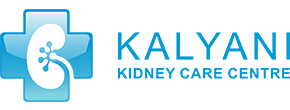INTRODUCTION
Kidney stones are stone-like lumps that can develop in one or both of the kidneys. Kidney stones are quite common and usually affect people who are between 30 and 60 years of age. However no age is immune and they occur in children as well.They affect men more than women. It is estimated that renal colic (severe pain caused by a kidney stone) affects about 10-20% of men, and 3-5% of women.
Kidney stones are hard, crystalline mineral deposits that form in the kidneys or urinary tract.
HOW DO KIDNEY STONES FORM?
Everyone forms crystals in their urine, even people who never form kidney stones. Urine, which is produced in the kidneys, naturally contains substances that promote the development of crystals. These stone promoters include calcium, oxalate, sodium, phosphorus and uric acid (and also cystine, in the case
of individuals with the inherited disorder known as cystinuria).
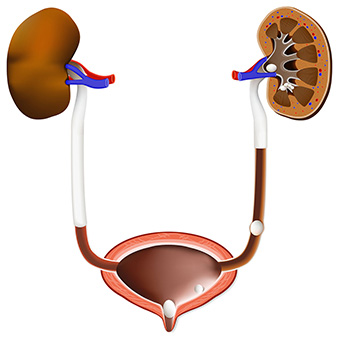
These stone-promoting compounds, which come from the bloodstream, are present in urine because the kidneys filter our blood and regulate whether and how much of these urinary constituents will be reabsorbed by the kidneys (put back into blood circulation) or eliminated as waste.
In addition to these stone promoters, urine also naturally contains proteins and other compounds that inhibit crystal formation. Examples of stone inhibitors in urine include total urine volume, citrate, magnesium, pyrophosphate, phytate and proteins and other molecules derived from normal metabolism, collectively referred to as urinary macromolecules. These inhibitor said the elimination of crystals before they attach to the kidney and grow into larger stones.
Thus, if the crystals remain small enough, and if the urine is dilute enough to avoid super saturation, crystals will flow with urine through the ureters and bladder without being noticed or causing problems. However, this balance between stone promoters and inhibitors does not exist for everyone - either due to genetic, lifestyle or other factors - leading to the formation of kidney stones.
SYMPTOMS THAT SHOW PRESENCE OF KIDNEY STONE
Stones in Kidney :
If there are stones inside your kidney, you will usually not get any pain in your abdomen. However, if the stone is big enough, you might experience dull aching pain.Sometimes renal stones are diagnosed without any symptoms, as incidentally detected during other diagnostic modalities.
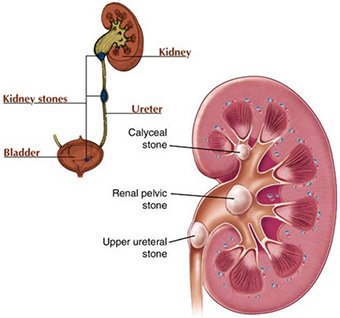
Stones in Ureter :
If there is a stone inside your ureter (the tube that passes from the kidney to the urinary bladder), you will get a sharp pain which starts from either of the loin depending on which side the stone is situated and the pain will spread down to your lower abdomen. The pain will be agonizing enough for you to seek medical help at the earliest.
If there are stones lodged inside both ureters, there is every possibility that you might not pass urine at all, in addition to pain in both loins. This is due to ureteric obstruction on both sides leading to acute kidney failure. In such a situation, you should seek emergency medical care. In these sorts of situations, your urologist will advise a procedure called bilateral ureteric stenting in which tubes will be inserted into both your ureters by going through the normal urinary passage. Such a procedure will relieve you of the pain and will also improve your kidney function. However, this procedure is only a temporary one and once your kidney function stabilizes, you will need a surgical procedure to remove the stones in both your ureters.
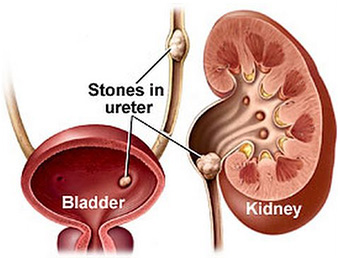
Stones in Ureterovesical Junction:
If there are stones lodged in this part of the ureter (the point where the ureter enters the urinary bladder), you will experience symptoms like burning sensation/pain while passing urine with increased frequency of urination in addition to loin pain. You might also pass blood in the urine.
Stones in Urinary Bladder:
If there are stones inside your urinary bladder (the organ that stores urine after receiving it from the kidneys), you might experience symptoms like burning sensation/pain while passing urine with increased frequency of urination with passage of blood in the urine. There might also be a sensation of urgency to pass urine.
Stones in Urethra:
If the stone has lodged in the urethra (the tube that leads from urinary bladder to the natural urinary orifice), you will have a blocked sensation while passing urine with slowness in the urinary stream. This is different from stones in Ureter (the tube that passes from the kidney to the urinary bladder)
TREATMENT OPTIONS
There are two ways by which you may be managed by your urologist.
A. Medical management:
For stones which are within the kidney and which are less than 10mm, the urologist will advise you to drink plenty of fluids and probably give you some medications which might help prevent stone formation. .Stones bigger than 10mm might need some form of surgical intervention.
For stones which are inside the ureter, the urologist will give you some pain killer medications and advise plenty of fluid intake if the stones are less than 10mm. Stones bigger than 10mm might need some form of surgical intervention.
B.Definitive management:
ESWL (EXTRACORPOREAL SHOCK WAVE LITHOTRIPSY):
In this procedure, stones which are upto1.5mm inside the kidney or in the upper ureter can be fragmented. This is usually done as a day care procedure wherein you can get discharged in the evening after undergoing the procedure in the morning. You will be subjected to shock waves emanating from a machine that will break the stones. No anaesthesia is required. The main disadvantage of this procedure is that not all stones can be fragmented with this procedure and even if the stones do fragment well, there may be a delay in passage of the fragments (sometimes upto 6 weeks). Complications are that you might get pain till all fragments are passed in the urine. If the fragments don’t pass out,you will need other procedures to remove the stones.
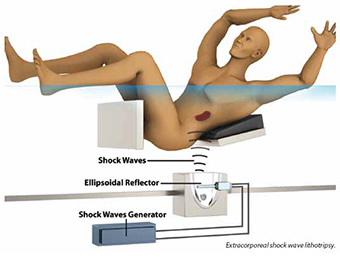
PCNL (PERCUTANEOUS NEPHROLITHOTOMY):
Here, stones within the kidney are removed by making a small key hole in your back. The stones are removed by a rigid straight instrument called the nephroscope and you can go home in 3 days and return back to your normal activities in a matter of a couple of days. Complications are bleeding which may require blood transfusion and sometimes a procedure called renal angioembolization (a coil is placed in the blood vessel that has ruptured and has led to bleeding) may be required.
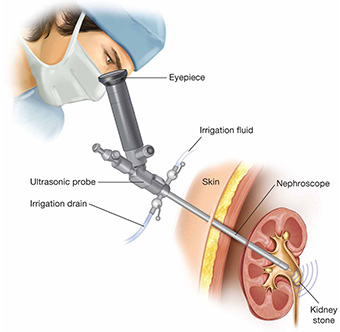
LASER KIDNEY STONE TREATMENT (or) RIRS (RETROGRADE INTRARENAL SURGERY OR FLEXIBLE URETEROSCOPY):
In this method, stones are removed by passing a flexible tube through the normal urinary passage. Stones within the kidney are fragmented using laser and removed. Stones of upto 3.5cm can be removed. Only a single day’s hospital stay is required. There are practically no chances of bleeding in contrast to PCNL and you can return to your routine activity the next day. However, the procedure is a bit expensive. This procedure is also a less morbid one than PCNL.
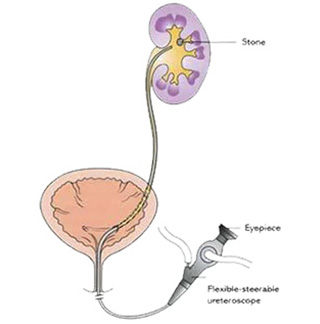
URS (SEMIRIGID URETEROSCOPY):
Here, stones within the ureter are removed by passing a straight tube via the natural urinary passage. Only a single day’s hospital stay is required and you can return to your routine activity the next day. Complications are that it may result in injury to the ureter.
In URS, PCNL and RIRS, the urologist may place a tube inside your ureter called a ureteric stent. This is to allow the normal urine flow from the kidney to the urinary bladder and also to allow some tiny stone fragments to pass out. The stent usually remains in place for up to 3 weeks after which it can be removed as a day care procedure under local anaesthesia. With the stent inside your body, you can carry on your regular activities and return to work but do make sure that you get it removed on the date stipulated by your urologist.The stent can cause minor problems to you like burning sensation while passing urine or a pain in the side of the loin where it has been inserted. This pain is usually due to the reverse passage of urine from the urinary bladder to the kidney and will gradually subside with time as the stent and ureter adapt themselves. In case these symptoms persist, you must seek medical care. If the stents are not removed for long time, it will be crystalized slowly and transformed into stones which can permanently damage your kidney. Hence removal of DJ Stent is must.
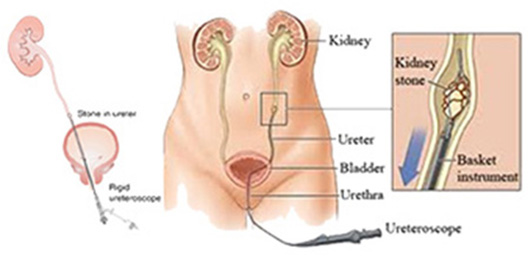
CYSTOLITHOTRIPSY:
Stones within the urinary bladder that are larger than 10mm are removed by this method. Here a straight tube is inserted into your urinary bladder via the natural urinary passage and the stone is broken and removed. This method is also used for stones within the urethra. Only a single day’s hospital stay is required
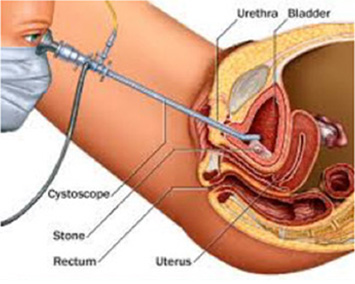
OPEN CYSTOLITHOTOMY:
Stones within the urinary bladder that cannot be removed by cystolithotripsy are removed by this method.
Here an open surgery is required and you will need 4 to 5 days of hospitalization.
COMPLICATIONS
General complications include urinary tract infection (symptoms may be fever with loin pain and burning sensation while passing urine) and stent related problems which have been highlighted before. Complications specific to the procedures have been enumerated previously.
1. What are kidney stones?
Kidney stones are hard, crystalline mineral deposits that form in the kidneys or urinary tract.
2. What causes kidney stones?
The exact cause of kidney stones is unknown, but several factors can contribute, such as dehydration, a diet high in oxalates or sodium, obesity, certain medical conditions, and genetics.
3. What are the symptoms of kidney stones?
Symptoms of kidney stones can include severe pain in the back, abdomen, or side, nausea, vomiting, fever, and pain or burning during urination.
4. How are kidney stones diagnosed?
A doctor may diagnose kidney stones using imaging tests, such as X-rays or CT scans, or by analyzing a urine sample.
5. How can kidney stones be prevented?
Kidney stones can be prevented by drinking plenty of water, maintaining a healthy diet, limiting salt and animal protein intake, and avoiding excessive consumption of foods high in oxalates, such as spinach, beets, and chocolate.
6. Who is at risk of developing kidney stones?
People who have a family history of kidney stones, have had kidney stones before, have certain medical conditions, or have a diet high in salt or oxalates are at a higher risk of developing kidney stones.
7. Can kidney stones pass on their own?
Small kidney stones may pass on their own with the help of drinking plenty of water and taking pain medication. However, larger stones may require medical intervention to remove or break them up.
8. What are the complications of kidney stones?
Complications of kidney stones may include urinary tract infections, kidney damage, or recurrent kidney stone formation.
9. What are the different treatment options for kidney stones?
Treatment options for kidney stones include drinking lots of water to help pass the stone, medication to alleviate pain or promote stone passage, or surgery or other procedures to remove the stone.
Tips to prevent kidney stone problem
Kidney stones are a common condition that affects millions of people across the world. They are hard, crystalline mineral deposits that form in the kidneys or urinary tract and can cause severe pain and discomfort. Kalyani kidney center will cure all your kidney stones issues with our expert doctors in erode.
Here are some tips to help prevent kidney stone problems:
– Drink Plenty of Water
One of the most effective ways to prevent kidney stones is to drink more water. Dehydration is a major risk factor for kidney stones, as it can lead to the concentration of urine and the formation of crystals. Drinking enough water ensures that urine is diluted, which reduces the risk of crystal formation. It is recommended to drink at least eight glasses of water a day.
– Reduce Sodium Intake
A diet high in sodium can increase the risk of kidney stone formation. Sodium increases the amount of calcium that is excreted in the urine, which can lead to the formation of calcium-based kidney stones. To reduce your sodium intake, limit processed and packaged foods, as well as salty snacks.
– Limit Animal Protein
Consuming too much animal protein, such as meat, poultry, and eggs, can increase the amount of uric acid in the urine, which can lead to the formation of uric acid stones. It is recommended to limit animal protein intake to less than six ounces per day.
– Avoid Oxalate-Rich Foods
Oxalates are a type of substance found in certain foods that can increase the risk of calcium oxalate stones. Foods that are high in oxalates include spinach, beets, nuts etc. While it is not necessary to avoid these foods entirely, it is recommended to consume them in moderation.
– Increase Citric Acid Intake
Citric acid can help prevent the formation of kidney stones by binding to calcium in the urine and preventing crystal formation. Citric acid is found in many fruits, including lemons, limes, oranges, and grapefruits. Drinking fresh-squeezed citrus juice or adding slices of citrus to your water can help increase your citric acid intake.
– Maintain a Healthy Weight
Obesity is a major risk factor for kidney stone formation. Excess weight can lead to insulin resistance, which can increase the amount of calcium in the urine. Maintaining a healthy weight through diet and exercise can help reduce your risk of kidney stones.
– Don’t Overdo Calcium
While calcium is an essential mineral for bone health, consuming too much calcium can increase the risk of calcium-based kidney stones. It is recommended to get your calcium from food sources, such as dairy products, rather than supplements.
– Avoid Vitamin C Supplements
Vitamin C supplements can increase the amount of oxalate in the urine, which can lead to the formation of kidney stones. It is recommended to get your vitamin C from food sources, such as citrus fruits, rather than supplements.
– Stay Active
Regular exercise can help reduce the risk of kidney stones by reducing insulin resistance and maintaining a healthy weight. Aim for at least 30 minutes of moderate exercise, such as brisk walking or cycling , running everyday.
– Be Mindful of Medications
Certain medications, such as diuretics, antacids, and calcium-based supplements, can increase the risk of kidney stones. If you are taking any medications, talk to your doctor about the potential risks and how to minimize them.
In conclusion, kidney stones are a painful and uncomfortable condition, but they can be prevented through lifestyle changes and healthy habits. By drinking plenty of water, reducing sodium and animal protein intake, and staying active, you can help reduce your risk of kidney stones and maintain good kidney health. If you have a history of kidney stones or are experiencing symptoms, it is important to consult with a best healthcare provider like kalayani kidney center in erode for proper diagnosis and treatment. Remember to always follow your healthcare provider’s advice and take any medications as prescribed. With proper prevention and treatment, you can maintain good kidney health and reduce the risk of kidney stone formation. contact kalyani kidney center for stone problem in and around erode.


